An initiative of the Transport Working Group of the regional LEDS LAC platform and the EUROCLIMA+/MobiliseYourCity Community of Practice.
The role of cities and mobility in confronting climate change is key in a context of increasing global urbanisation, particularly in emerging and developing economies. This requires articulated efforts to guide actions on mobility that involve local and national levels, as well as other sectors. One of the ways to achieve this is through National Urban Mobility Policies (NUMP).
National Urban Mobility Policies (NUMPs) are action-oriented strategic frameworks for urban mobility developed by national governments to improve the capacity of cities to plan, finance and implement projects and measures designed to meet the mobility needs of people and businesses in and around cities in a sustainable manner.

With the aim of making the importance of the NUMPs visible, the necessary elements to develop them, as well as the promotion of the experiences of two Latin American countries, the webinar "The importance of developing national urban mobility policies for the sustainable development of cities: Introduction to the concept and the NUMP guide" was held on April 14. The event was co-organised by the Transport Working Group of the LEDS LAC Regional Platform and the Community of Practice "Sustainable Urban Mobility Platform in Latin America" of EUROCLIMA+ / MobiliseYourCity.
The webinar provided an introduction to the NUMP concept and its importance for the sustainable development of cities. It also detailed the process for preparing a NUMP through the guide developed by the global initiative MobiliseYourCity. In addition, Ecuador and Uruguay presented their experiences and challenges in the NUMP preparation process that they are carrying out under the framework of the EUROCLIMA+ programme. The welcome and moderation was the responsibility of Carolina Chantrill, coordinator of the Transport Working Group of LEDS LAC.
Below, we present the most outstanding lessons learned during the virtual event.
The mobility and carbon neutrality paradigm
Cities and mobility have had a long history of collective transformation. Mobility and public space was people-centred when there was no energy consumption for moving around, such as walking. Advances in public transport made it possible to facilitate people's connectivity in cities, which led to their growth.
Along with technological advances and the development of new production processes, the automobile took priority, which began to produce urban segregation, road congestion and increased energy consumption. How do we change paradigms to return to more humane, sustainable and people-centred cities?
Andrea Palma, GIZ technical advisor for the EUROCLIMA+ programme, presented the Avoid, Shift and Improve paradigm, an approach to more holistically design the overall sustainable transport system.
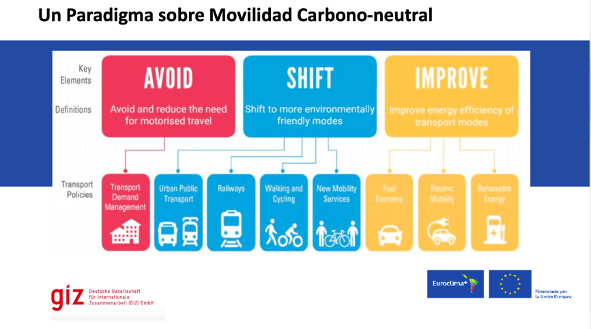
“With this paradigm, we believe that it holistically covers innovation in mobility and responds to the diversity of solutions required for people, development, access, energy and sustainability in our cities," said Andrea Palma.
With this vision, together with the MobiliseYourCity NUMP methodology, the advisor explained that GIZ and the EUROCLIMA+ programme promote transformation processes using a collaborative approach, involving different key actors to set priorities, linking them with national climate policies and with a clear delimitation for implementation, monetisation of solutions, capacity building and technological innovation.
A multi-sectoral approach
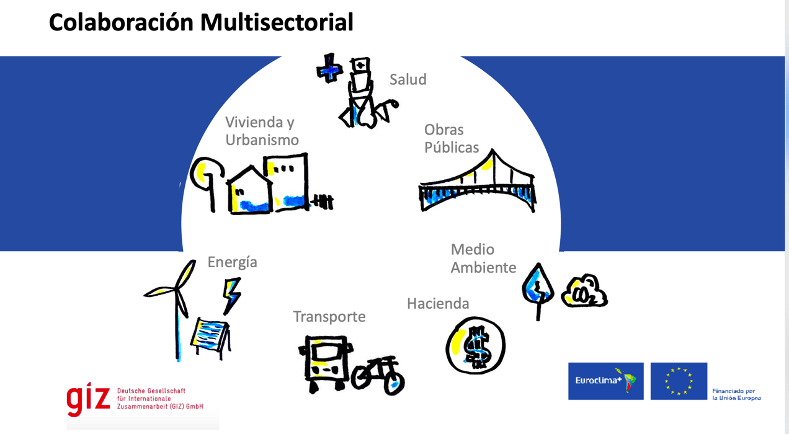
One of the opportunities of the National Urban Mobility Policies is to strengthen multi-sectoral collaboration within the government, "transport problems are not problems of the Ministry of Transport alone, but of a set of key ministries such as energy, finance and environment", explained Andrea Palma.
Local, regional, and national governments have different responsibilities for sustainable urban mobility. The national government creates conditions, the regional government administers, and the local government implements. Therefore, it is necessary to design policies that are good, but also ready to be implemented. For this, it is important to take into consideration:
- Foresight: Understanding contexts, prioritising policies, having key objectives.
- Concrete Measures: Have national measures, an implementation plan, and a resource allocation plan.
- Local engagement: Link to the local context so that cities have implementation plans, local leadership and citizen participation is strengthened.
The Guide for developing NUMPs
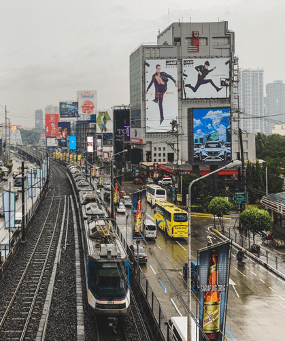
Mateo Gomez Jattin, consultant at the MobiliseYourCity Secretariat, presented the NUMP Guide of MobiliseYourCity, an instrument to guide countries in the preparation of National Urban Mobility Policies. The document is the result of a long cooperation experience with more than 15 countries and international development agencies.
NUMPs build on existing policies and seek to harmonise, improve, and expand these frameworks to orient them towards sustainable urban mobility. Therefore, the Guide is a document that provides a practical methodology for decision-makers on how to develop a NUMP.
This is a standardised, flexible, and modifiable methodology. It does not attempt to provide a universal set of steps, nor does it prescribe the types of measures or approach to be taken, instead it emphasises the importance of each government appropriating the methodology to its different national and local needs and contexts through a participatory and transparent process.
"The NUMP Guide does not focus on the content of a policy, but on the specific elements," said Mateo Gomez.
The document is structured using what MobiliseYourCity calls the NUMP Cycle, which reflects the strategic and process-based approach of the methodology. It is a process consisting of four stages and 15 specific steps. Each stage aims to answer 4 fundamental questions: 1) What is the current state of urban mobility?, 2) What is the long-term vision and objectives of sustainable urban mobility to be achieved?, 3) How to achieve the stated objectives?, 4) How to measure the progress of the implementation?, Transversal to the phases and steps, the cycle offers two transversal actions: funding and MRV (Monitoring-Reporting-Verification).
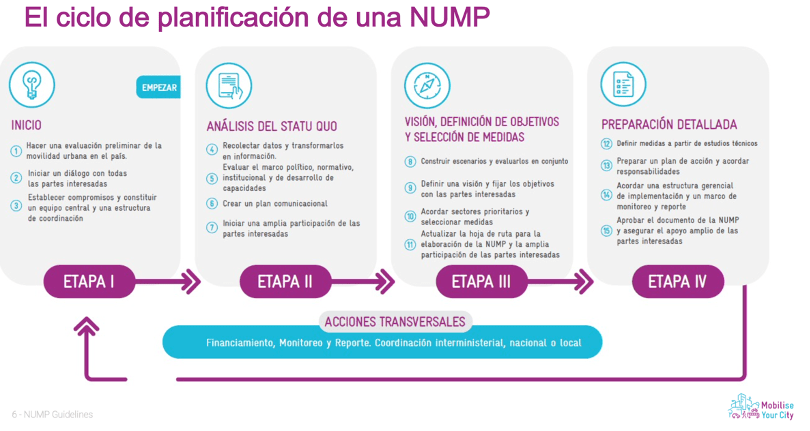
Experiences of Ecuador and Uruguay
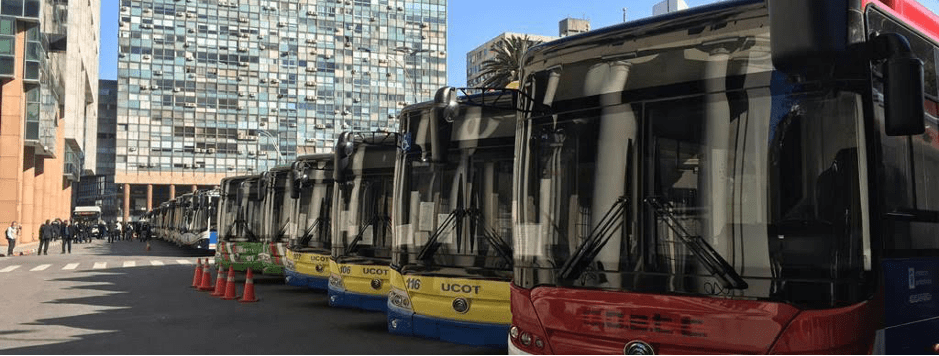
For their part, Ecuador and Uruguay shared their experiences regarding the National Urban Mobility Policies they are developing under the framework of the EUROCLIMA+ programme. In 2018, both countries were selected to receive funding and technical support.
Juan Pablo Torres, a specialist in regulatory and railway regulation at the Ministry of Transport and Public Works, gave an overview of how the work dynamics have been established to develop Ecuador's NUMP.
Ecuador's National Urban Mobility Policy aims to cover territorial and urban planning, mobility planning, and addressing population and city growth. Its proposal is to generate equitable access to mobility opportunities, promote non-motorised transport, optimise public transport management, and offer economic incentives for GHG reduction in transport.
In 2020, the contracting of the consultancy for its preparation began. A four-phase work process was established, from 2020 to 2022: Diagnosis and benchmarking, Vision and definition of objectives, Strategic analysis and Drafting and socialisation. Currently, they are in the final steps of the first phase, in which an analysis of NUMPs developed in France, Spain and Brazil, a preliminary diagnosis of mobility in Ecuador, a proposal for the classification of cities and a mapping of key actors were carried out. According to Juan Pablo Torres, the importance of these last two points lies in the need to develop a policy that has the flexibility to propose measures that can be adapted to cities with different needs and realities, and that take into account the needs and interests of as many stakeholders as possible.
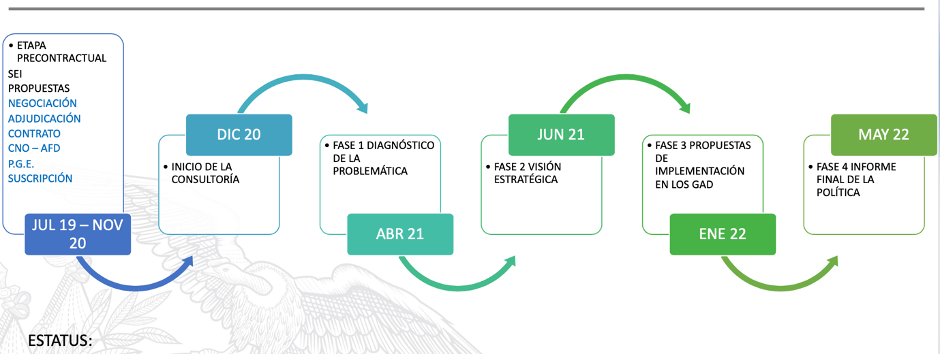
For the case of Uruguay, Antonella Tambasco, advisor at the Ministry of Industry, Energy and Mining, presented Uruguay's experience in the preparation of its NUMP, which is carried out closely with the Ministries of Environment, Housing and Territorial Planning, Economy and Finance, as well as Transport and Public Works.
After presenting the strategic and regulatory framework for sustainable mobility in Uruguay, as well as its current situation, the advisor explained the process to develop the National Urban Mobility Policy that they have been working on since 2019. It is divided into four phases: Diagnosis, Vision and Objectives, Guidelines and Measures --which they are in at present-- and Validation. The Diagnosis phase has included a series of participatory processes, technical consultancies, and departmental workshops with the aim of articulating existing levels, actors, and public policies.
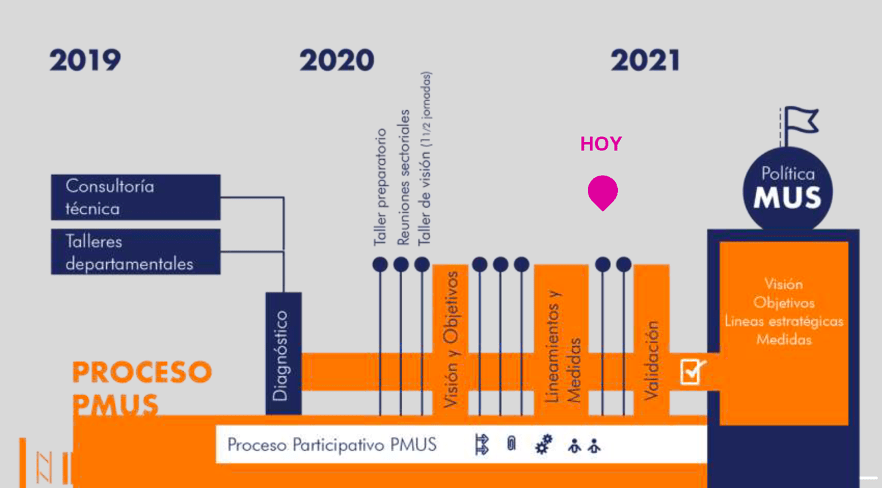
To integrate the NUMP and ensure clear guidelines for its implementation, the project also envisages the realisation of guidelines, such as Sustainable Urban Mobility Planning, Electromobility and an Electromobility Financial Mechanism.
You can watch the full video of the session below:
About EUROCLIMA+
EUROCLIMA+ is a programme funded by the European Union to promote environmentally sustainable and climate-resilient development in 18 Latin American countries, particularly for the benefit of the most vulnerable populations. The Programme is implemented under the synergistic work of seven agencies: the Spanish Agency for International Development Cooperation (AECID), the French Development Agency (AFD), the Economic Commission for Latin America and the Caribbean (ECLAC), Expertise France (EF), the International and Ibero-America Foundation for Administration and Public Policies (FIIAPP), the German Society for International Cooperation (GIZ), and UN Environment.
For more information:
This email address is being protected from spambots. You need JavaScript enabled to view it.euroclimaplus.org
www.euroclimaplus.org
